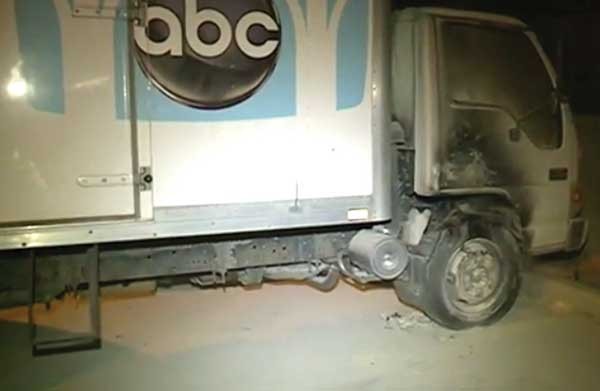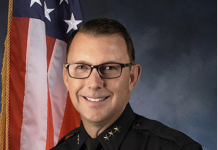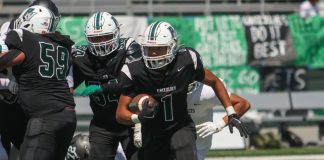SALINAS — A fire that damaged a vehicle at KSBW’s Salinas headquarters Friday night was likely arson, Salinas Deputy Fire Chief Brett Loomis said Monday.
According to Loomis, an unknown suspect started the fire in a wheel well of a vehicle belonging to the news agency at about 10:20 p.m.
A KSBW employee extinguished the fire, but not before it caused about $2,000 in damage, Loomis said.
There is no known motive for the arson, he said.
There is no suspect information, Salinas Police Department spokesperson Miguel Cabrera said.
KSBW President and General Manager Joseph Heston said that the station did not report any controversial topics in the week before the arson occurred that might have caused someone to target the station.
“All of us are profoundly saddened, and I am disgusted that someone would choose to do this,” Heston said. “We’re disappointed, but we’re going to continue doing what we do and have done for the past 65 years.”
While the motive for the KSBW arson is unclear, it comes in a time when ire toward the media, fueled by right-wing rhetoric, is at an all-time high.
Television news photographer Lori Bentley-Law decided to quit the business after 24 years, citing attacks on the media as one of her reasons.
Bentley-Law’s recent blog post explaining why she was leaving Los Angeles’ KNBC-TV hit home for many colleagues.
While President Donald Trump’s attacks on the media are usually centered on national outlets like CNN and The New York Times, the attitudes unleashed have filtered down to journalists on the street covering news in local communities across the country.
When a president describes the press as enemies of the people, “attitudes shift and the field crews get the brunt of the abuse,” she wrote. “And it’s not just from one side. We get it all the way around, pretty much on a daily basis.”
The Radio Television Digital News Association is spreading safety and self-defense tips to journalists, most notably advising limits on the use of one-person news crews. The RTDNA has begun compiling anti-press incidents, like last week when an intruder was shot after kicking down glass doors at Fox’s local station in Washington. The National Press Photographers Association is developing workshops to spread safety advice to its members.
“The environment has changed,” said Chris Post, a photographer for WFMZ-TV in Allentown, Pennsylvania. “I’ve witnessed the transition.”
CNN White House correspondent Jim Acosta made news last week by saying Trump’s attacks on the media “have got to stop” because he feared someone would get hurt. He’s been the target of chants and epithets when covering Trump rallies, including one recently where a man looked at him and made a motion like he was slitting a throat. Since then, three suspicious packages have been addressed to separate CNN offices.
While the examples of Acosta and others who follow Trump are most visible, there are countless other, more private examples that happen across the country — like when Post arrived to cover an immigration rally and a man in a car asked him where he was going.
Told it was a pro-immigration rally, the man became agitated and stepped on his accelerator, stopping just short of hitting Post and giving him a self-satisfied look, Post recalled.
“I’m 6-foot-5, 300 pounds,” he said. “I’ve had somebody try to grab my camera. When it gets to that point, where does it stop? It’s a tough time to be a journalist.”
Caitlin Penna, a freelance photographer from Durham, N.C., said she constantly has her guard up on assignments. Even her conservative family is suspicious of her.
“I’m pretty sure my grandmother thinks I’m this far-left liberal because of the things I cover,” she said.
One night she was unwinding at a local bar and struck up a conversation with a man nearby. When she discussed what she did, the man said, “You report fake news” and walked away.
Bentley-Law was startled when the essay on leaving her job got 11,000 hits in three days. She usually counts readers to her personal blog in the dozens. Her intention was to tell friends and colleagues why she was leaving, and instead was flooded with texts and emails from frustrated journalists across the country.
“I suppose my experience isn’t unique and certainly resonated,” Bentley-Law, who declined to be interviewed, said via email.
On her blog, she wrote that “I don’t want to be immersed in sadness every day. I don’t ever want a cute little girl in pigtails to look up at me and say, ‘We hate you.’ I don’t want to hear ‘fake news’ shouted at me anymore, or to be flipped off while driving my news van.”
She said that some of the incidents she wrote about — the hateful little girl and the man who stuck his bare butt out the window and defecated — predate Trump. There are other factors that contributed to her desire to leave, including shoulder woes from carrying heavy equipment for many years and a constant diet of murders and other depressing story assignments.
But the current environment is definitely part of it. People who drive vans emblazoned with a television station’s call letters are obvious targets. One recent day, Bentley-Law wrote that a person in a Mercedes prevented her van from getting off a highway until several exits beyond her destination.
So far this year the RTDNA’s “press freedom tracker” counts 39 incidents of journalists being attacked in the United States, including the June 28 shooting at the Capital Gazette in Annapolis, Maryland, where five people were killed. In less lethal examples, a man purposely crashed a pick-up truck into the side of a Dallas television station, a Miami reporter and a photographer were physically attacked while doing a live shot and a North Carolina crew had its power cable cut while covering a demonstration.
Last year, the first time a count was kept, there were 48 such cases for all of 2017.
•••
The Associated Press contributed to this report.











